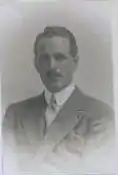Arthur Edward Flynn Fawcus
Lieutenant-Colonel Arthur Edward Flynn Fawcus DSO MC TD (19 October 1886 – 10 August 1936), was awarded the Military Cross for leading a night attack at Cape Helles in August 1915 at the beginning of the Gallipoli Campaign, awarded the Croix de Chevalier of the Légion d'honneur for his bombing work in the Gallipoli Campaign, awarded the DSO for his Command of a Battalion of the 1/5th North Staffordshire Regiment toward the end of World War I and was afterwards Commander of the 1/5th Sherwood Foresters.[1][2][3]
Arthur Edward Flynn Fawcus | |
|---|---|
 | |
| Born | 19 October 1886 Keswick, Cumbria, United Kingdom |
| Died | 10 August 1936 (aged 49) Pagham, United Kingdom |
| Allegiance | |
| Service/ | |
| Rank | Lieutenant-Colonel |
| Commands held | 1/5th North Staffordshire Regiment 1/5th Sherwood Foresters |
| Battles/wars | World War I Gallipoli Campaign |
| Awards | Chevalier, Légion d'honneur Distinguished Service Order Military Cross Territorial Decoration Mentioned in Despatches (4) |
Biography
Fawcus was born on 19 October 1886 in Keswick, the second son of W.P.J. Fawcus.[2][1] He was educated at Bedford Modern School.[4]
Fawcus was on active service with the Marakwet Patrol in British East Africa in 1911 and mentioned in despatches.[2][1] At the outbreak of World War I he was on active service the next day with the King's African Rifles in German East Africa where he served until February 1915 before being sent to Egypt with the 7th Manchester Regiment.[1]
In May 1915, Fawcus was in Gallipoli with the 7th Manchesters and the 1/6th Lancashire Fusiliers where he was awarded the Military Cross for leading a night attack at Cape Helles in August 1915.[2][1][5] He was made a Chevalier of the Legion of Honour for his bombing work during the Gallipoli Campaign.[2][1][6][7][8]
From January to July 1916, Fawcus was in Egypt with the 7th, 8th and 9th Manchesters and then served in France until 1918.[2][1] As Commander of a battalion of the 1/5th North Staffordshire Regiment he was awarded the Distinguished Service Order in June 1918[9][10] and he later commanded the 1/5th Sherwood Foresters for eighteen months.[2][1] During World War I he was mentioned in despatches three times.[2]

Fawcus was killed in an aeroplane crash at Pagham in the United Kingdom on 10 August 1936.[2][1][11] The pilot, Michael Richard Montagu, was apparently attempting a third loop the loop over the sea when the engine choked and the plane plunged into shallow water killing Fawcus and Montagu.[12] Montagu was a stepson of Lord Kimberley.[12]
Fawcus married Alexandra James in 1918, the daughter of Mr & Mrs William James of West Dean House, Chichester, Sussex who were friends of King Edward and Queen Alexandra.[1] There is a photograph of his wife at the National Portrait Gallery.[13] He was survived by his wife, two sons and a daughter.[1] He was well known in East Africa where he'd lived in Kenya and Tanganyika.[1] One of his sons, James Fawcus, was killed in March 1945 whilst serving with the King's Royal Rifle Corps.[14]
References
- Obituary, Lieut.-Col. Fawcus, A Fine War Record, The Times, 11 August 1936, p.14
- Who Was Who, Published by A & C Black
- https://www.thegazette.co.uk/London/issue/30217/supplement/7989/data.pdf
- War Honours Won By Old Boys, Bedford Modern School, Published by H.W. Robinson, Bedford, 1931
- https://www.thegazette.co.uk/London/issue/29460/supplement/1337/data.pdf
- "Page 2067 – Supplement 29486, 22 February 1916 – London Gazette – The Gazette". thegazette.co.uk. Retrieved 29 March 2015.
- https://www.thegazette.co.uk/London/issue/29486/supplement/2067/data.pdf
- "Page 98 – The-History-of-the-Lancashire-Fusiliers-1914-1918-Volume-I". militaryarchive.co.uk. Retrieved 28 March 2015.
- https://www.thegazette.co.uk/London/issue/30716/supplement/6458/data.pdf
- https://www.thegazette.co.uk/London/issue/30854/supplement/9769/data.pdf
- "1936 – 2297 – Flight Archive". Flightglobal. Retrieved 28 March 2015.
- Six Dead in Air Accidents, The Times, 11 August 1936
- "National Portrait Gallery – Person – Alexandra Maud Fawcus (née James)". npg.org.uk. Retrieved 28 March 2015.
- "Eton College Rolls of Honour-To the fallen of Eton College 1939–1945 who served in the KRR. Retrieved March 2015".